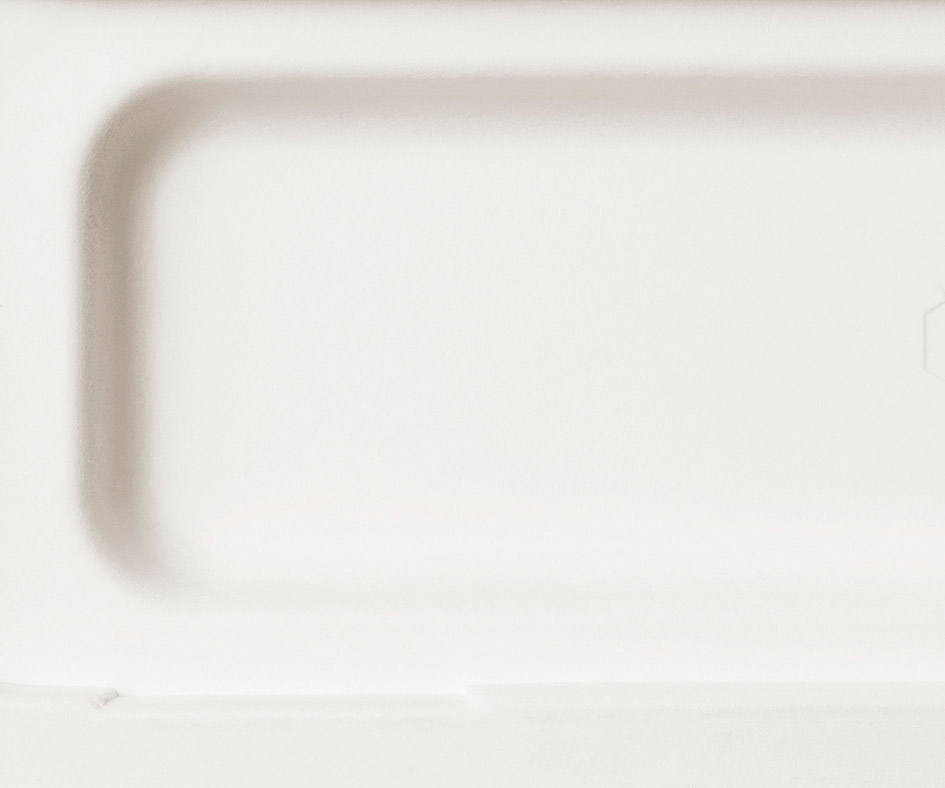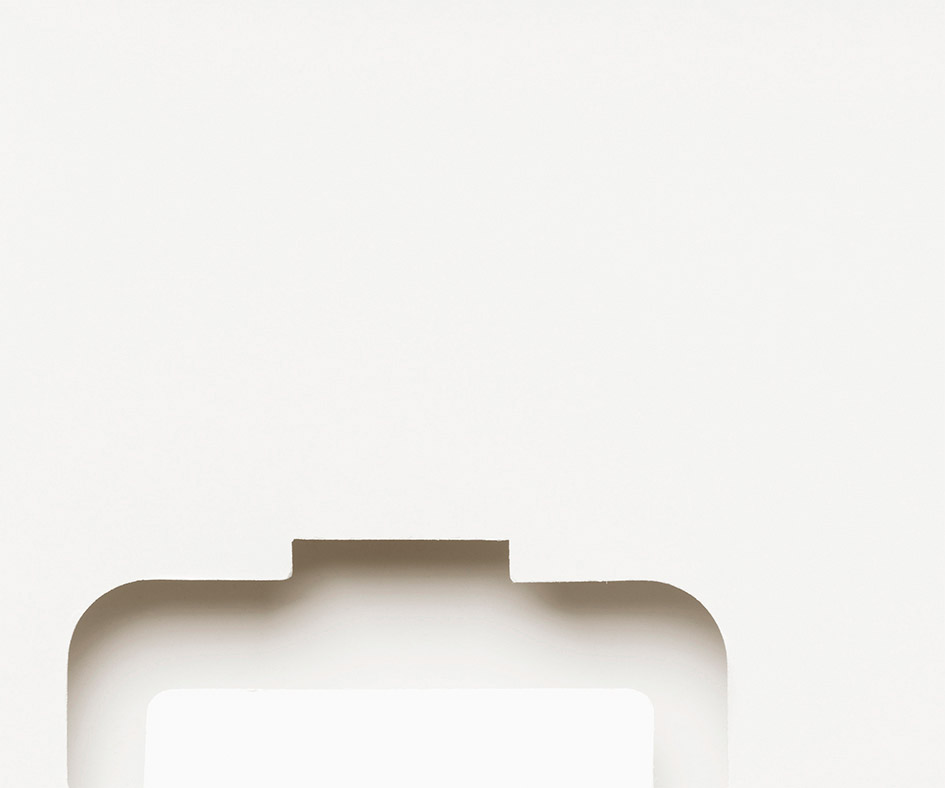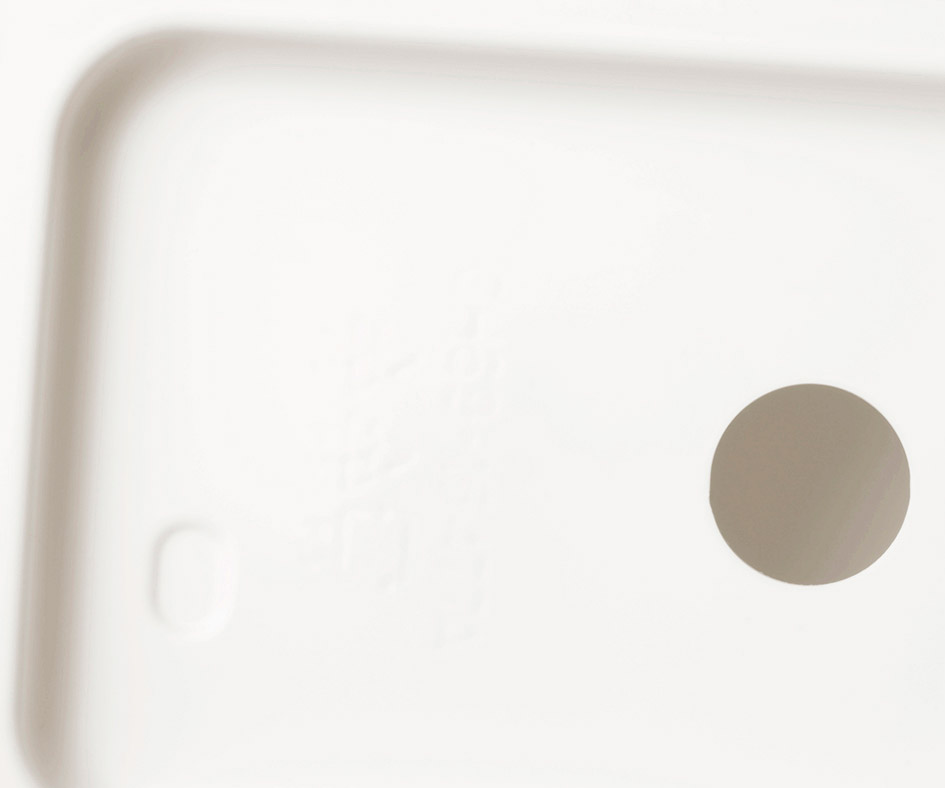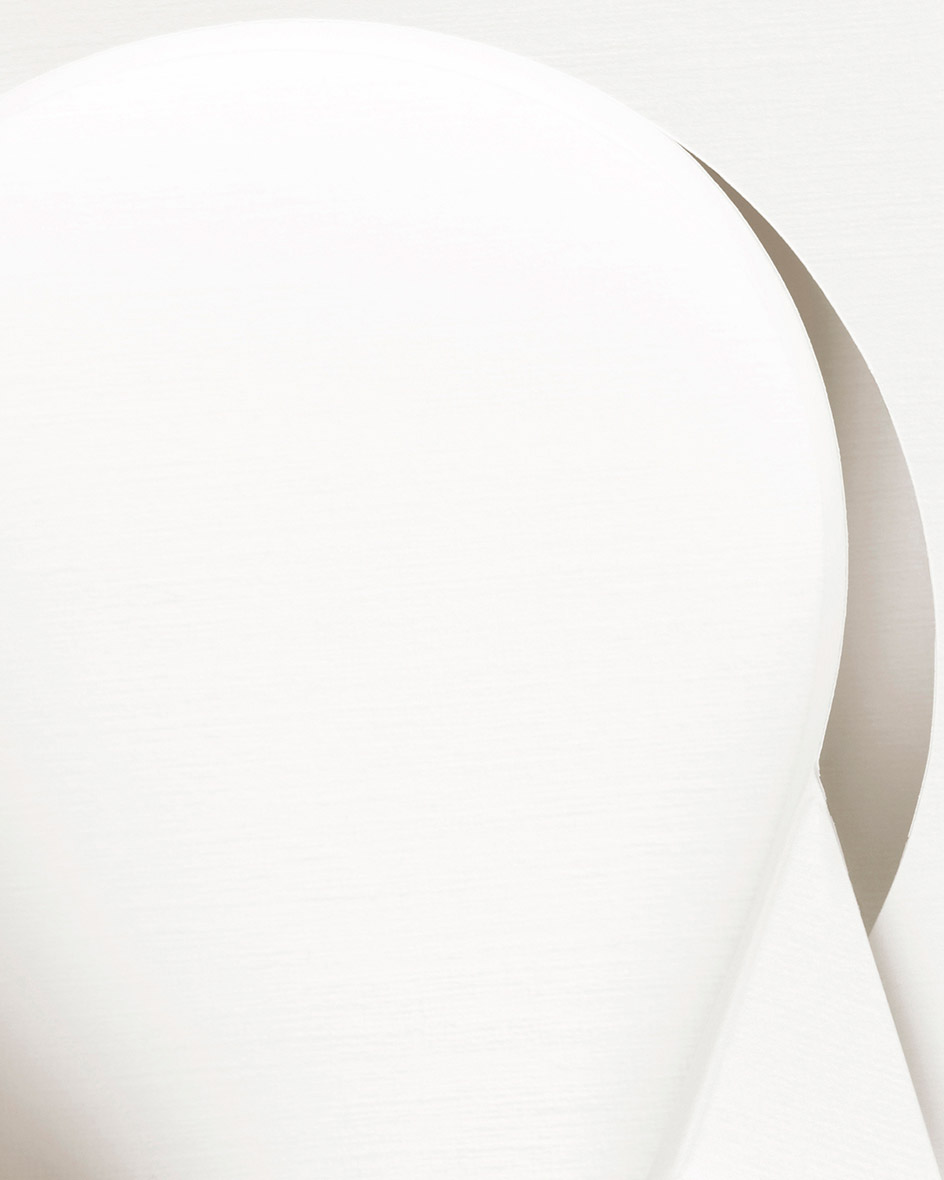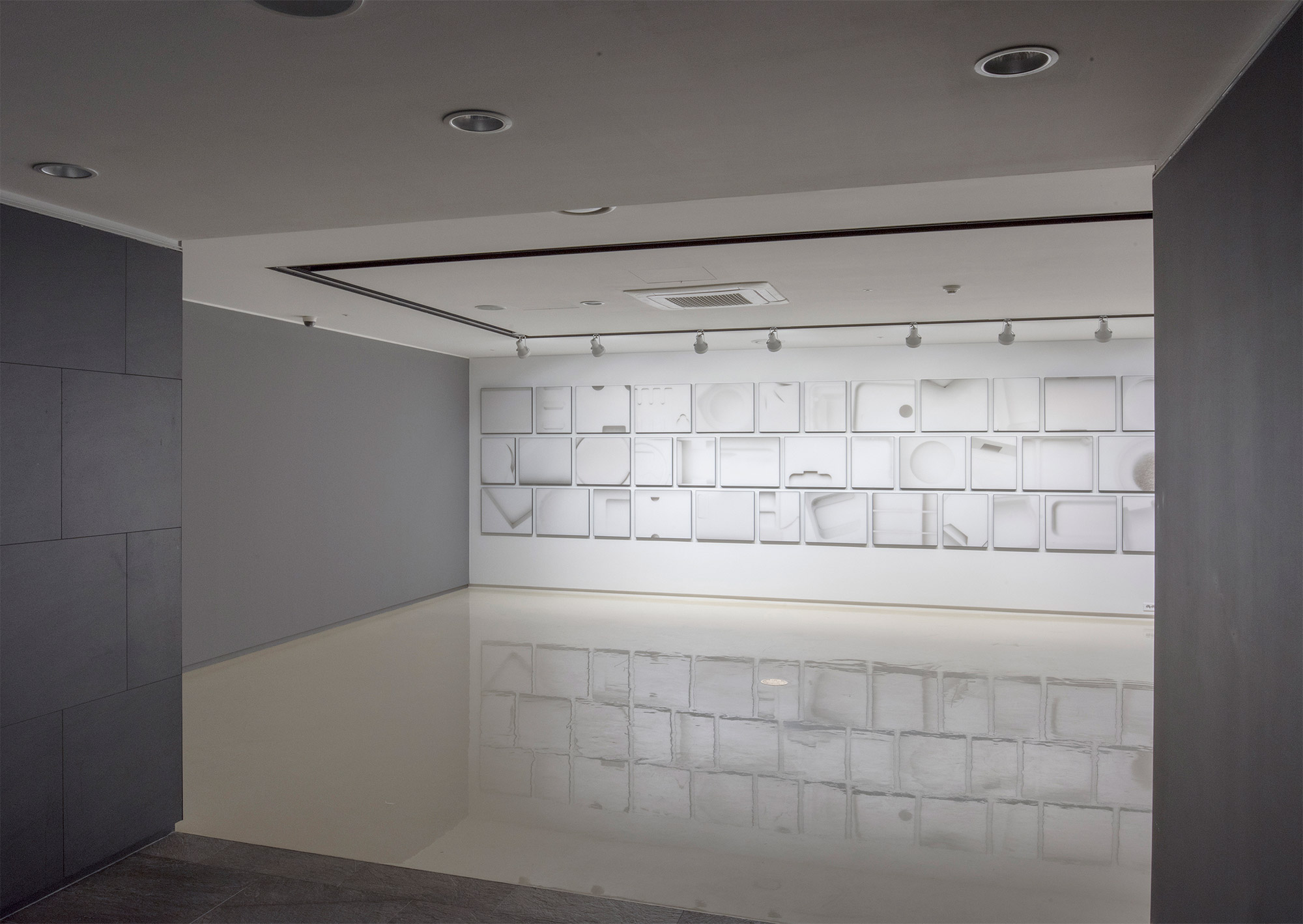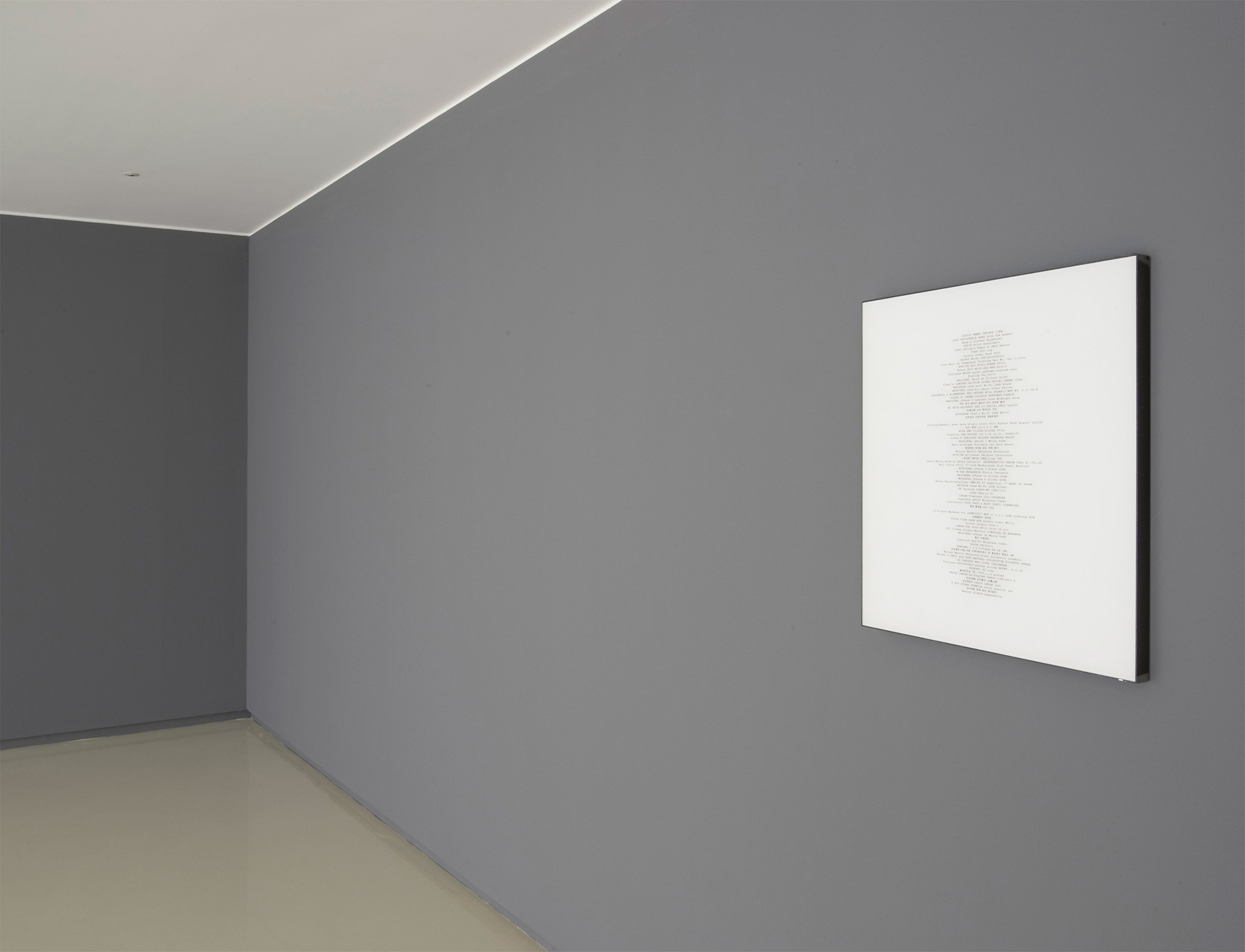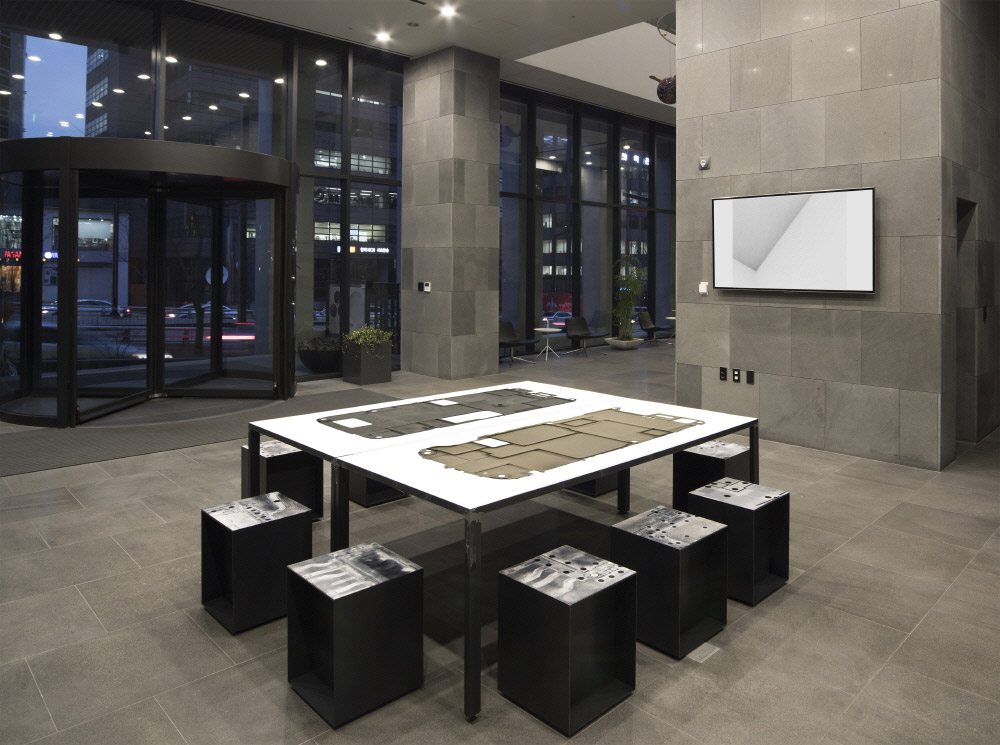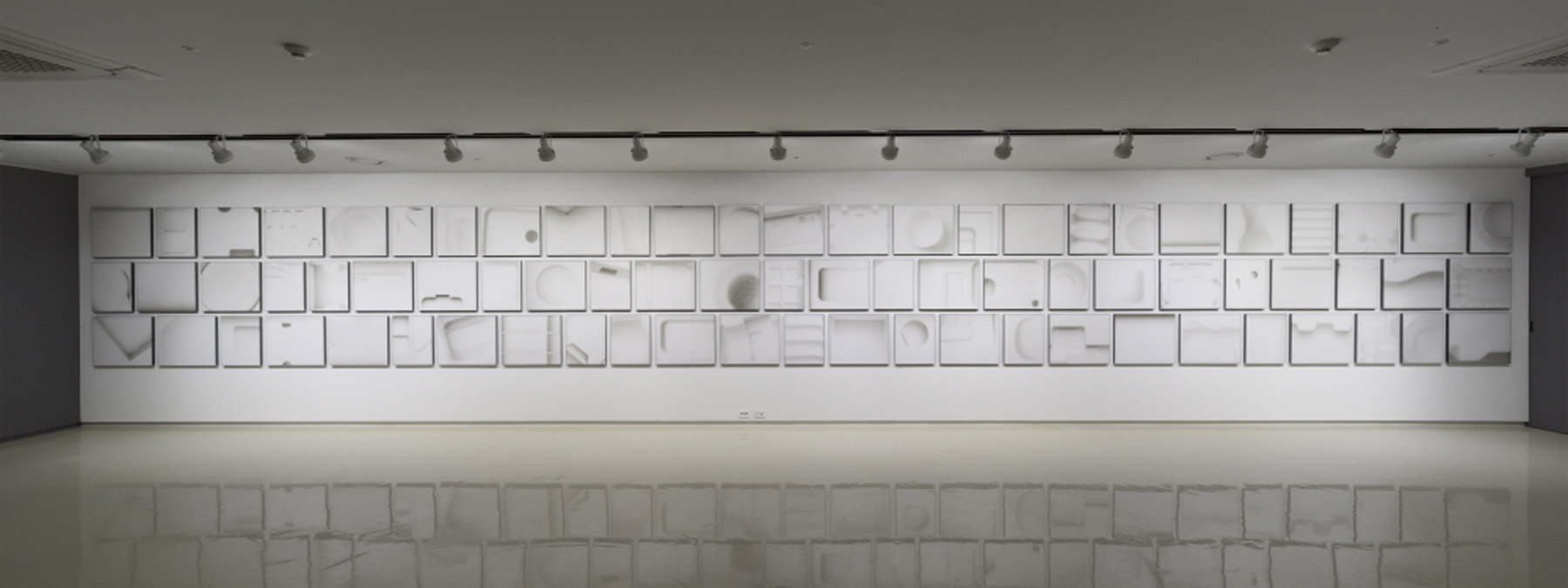Exhibitions
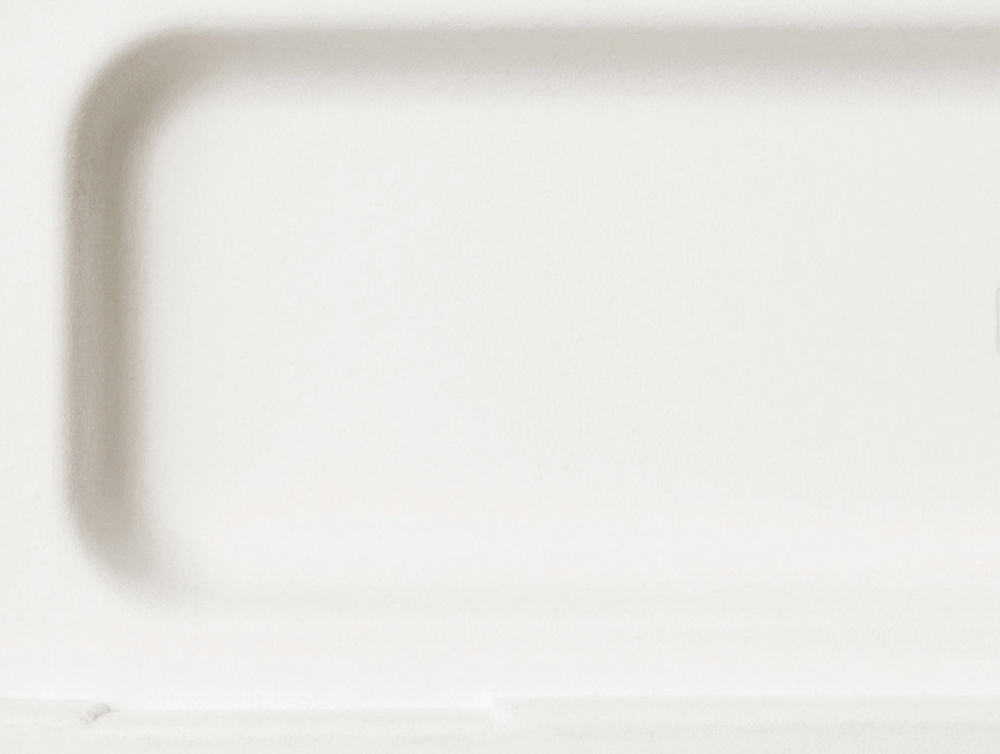
PERIGEE ARTIST #4 KDK
P
2015.03.12. THU ~
2015.05.09. SAT
빈 공간을 채우는 빛과 그림자
신승오(페리지 갤러리 디렉터)
KDK는 지속적으로 대상의 외형을 통해 그 구조를 드러내는 구축적인 작업을 해오고 있다. 이러한 작업의 경향은 근래에 들어서 서서히 변화를 하고 있는 중이다. 이는 건물의 내부나, 공간들에서 나타나는 공간의 면과 면이 만나는 모서리를 통해 현실과 비현실적인 공간을 넘나드는 작품을 보여줌으로써 또 한번 작업의 스펙트럼을 넓혀가고 있다.그의 작업에서 또 다른 특징으로 나타나는 것은 작품의 제목들이다. 그는 작품의 제목을 알파벳 이니셜로 사용하고 있는데, 이는 작품에 나타나는 이미지들과 관련된 것으로 작품에서 작품의 이름을 유추해 볼 수 있는 단어들의 약자이다. 따라서 그 작품들이 촬영된 장소나 건물의 이름이 될 수 도 있고, 어떤 느낌이나 분위기를 나타내는 단어 일 수도 있다. KDK가 이렇게 암호와 같은 작품 제목을 사용하는 이유는 작가에 의해 작품이 하나의 의미로 고정 되어버리는 경직성을 경계하기 위함이다. 이렇게 이니셜로 만들어진 작품 제목들로 인해 작품들은 고정된 의미에서 다중의 의미, 작가의 의도와 상관없이 관객들이 자신들의 시각으로 재해석할 수 있는 여지를 주어해석의 폭이 넓게 열려 있는 기능을 하게 된다.이를 통해 우리는 작가가 자신의 작업이 특정한 메시지를 전달하기 위한 수단이 아니라 관객들이 스스로 작업과의 유희를 통해 교감할 수 있는 장을 마련하고 있음을 엿볼 수 있다. 이와 같이 작가는 최대한 자....
Light and Shadow Filling an Empty Space
Seung Oh Shin, Perigee Gallery Director
Artist KDK has consistently created constructive work revealing structure through an object’s outward appearance. This tendency of his work has been gradually changing. He has once again broadened the spectrum of his work by going beyond the space between reality and unreality through a building’s interior and an edge where a plane meets another plane. His titles are another hallmark of his work. The single English letters he uses for his work’s titles are associated with the images his works depict. The letters are abbreviations for words we can only infer by viewing the work. They could correspond to places where his works are shot, building names, or words representing some feeling or atmosphere. KDK uses code-like titles because he doesn’t want the meaning of his work to be fixed. With these suggestively subdued titles his works can have multiple meanings and can be interpreted by viewers irrespective of his intention. That is to say, his works are open to extensive interpretations. With such titles, the artist seems to pr....
신승오(페리지 갤러리 디렉터)
KDK는 지속적으로 대상의 외형을 통해 그 구조를 드러내는 구축적인 작업을 해오고 있다. 이러한 작업의 경향은 근래에 들어서 서서히 변화를 하고 있는 중이다. 이는 건물의 내부나, 공간들에서 나타나는 공간의 면과 면이 만나는 모서리를 통해 현실과 비현실적인 공간을 넘나드는 작품을 보여줌으로써 또 한번 작업의 스펙트럼을 넓혀가고 있다.그의 작업에서 또 다른 특징으로 나타나는 것은 작품의 제목들이다. 그는 작품의 제목을 알파벳 이니셜로 사용하고 있는데, 이는 작품에 나타나는 이미지들과 관련된 것으로 작품에서 작품의 이름을 유추해 볼 수 있는 단어들의 약자이다. 따라서 그 작품들이 촬영된 장소나 건물의 이름이 될 수 도 있고, 어떤 느낌이나 분위기를 나타내는 단어 일 수도 있다. KDK가 이렇게 암호와 같은 작품 제목을 사용하는 이유는 작가에 의해 작품이 하나의 의미로 고정 되어버리는 경직성을 경계하기 위함이다. 이렇게 이니셜로 만들어진 작품 제목들로 인해 작품들은 고정된 의미에서 다중의 의미, 작가의 의도와 상관없이 관객들이 자신들의 시각으로 재해석할 수 있는 여지를 주어해석의 폭이 넓게 열려 있는 기능을 하게 된다.이를 통해 우리는 작가가 자신의 작업이 특정한 메시지를 전달하기 위한 수단이 아니라 관객들이 스스로 작업과의 유희를 통해 교감할 수 있는 장을 마련하고 있음을 엿볼 수 있다. 이와 같이 작가는 최대한 자신의 주관적인 감정을 대상에서 배제하고, 객관성을 유지하여 피사체 그 자체를 보여주고자 한다.그는작업에서 사람들이 만들어낸 것을 지속적으로 소재로 삼고있으며, 이런 대상을 자신의 개인적인 감성의 시선으로만 파악하는 것이 아니라 객관적인 시선을 가지려고 노력하면서 자신만의 사진 언어를 구축하고자 한다. 최근 미술계에서의 사진작업들은 디지털 이미지를 통해 컴퓨터를 통해 이미지를 보정하거나 변형시키는 과정이 작업의 큰 비중을 차지하는 경향이 강하다. 그 또한 이 과정을 거치지 않는 것은 아니다. 그러나 이러한 후반작업들은 대상에 집중되는 효과를 높이기 위한 용도로 사용되는 것으로 원본 자체에 변화를 주어 이미지를 과도하게 변형하지는 않는다. 최대한 피사체 그 자체에서 나오는 형태와 색, 구조를 온전히 드러내는데 집중한다. 이러한 그의 작업 태도가 그의 작업이 풍부한 색채를 드러내는 이유이다. 뿐만 아니라 그의 작업은 최근 들어 차갑고 어두운 느낌이라기 보다는 온기가 있으면서도 부드러운 표면을 가진다. 앞으로도 다시 언급하겠지만 이렇게 KDK의 작업은 여러 가지의 혼재된 요소들로 인하여 다양한 해석이 가능한 고정된 의미를 가지기 보다는 자유로운 이미지로 볼 수 있다.
그렇다면 이제는 이러한 KDK의 기본적인 작업의 성향을 바탕으로 이번 개인전에 선보이는 작업들을 살펴보자. 이번 작업의 시리즈 제목은<p>이다. 이전의시리즈들의 제목들이 모두 다중의 의미를 가지고 있었던 것과 같이 <p>시리즈도소재로 삼고 있는 Package, 전시하는 공간의 이름인 Perigee, 순수함을 뜻하는 Pure등 다양한 의미의 단어들로 증폭될 가능성을 내포하고 있다. 이것을 KDK의 작품을제목에서 유추해볼 수 있는 단어들과 연관 지어 본다면 또 다른 흥미로운 지점들을 작업에서 발견할 수 있을 것이다. 먼저 소재적인 부분을 살펴보도록 하자. 사람이 만들어내는 모든 것들에는 다양한 네러티브들이따라 붙는다. 이는 시간이 지날수록 그들만의 이야기가 쌓여가며 그 정체성을 드러낸다. 이렇게 우리가 살고 있는환경은 인공적인 것들과 그들의 이야기들로 가득 차 있다. 자연으로 눈을 돌려도 사람의 발길이 닿는 어디든 이러한 인공적인 것들이 없는 곳이 없다. 하지만 우리들은 이들을 우리에게 익숙한 기본적인 환경으로 인식하기 때문에 평소에는 무감각하게 지나친다. 그러나 조금만 시각을 달리해서 집중하고 관심을 갖는다면 사람의 손에 의해 만들어지는 것들은 경이롭다. 그 중에서도 가장 사람의 능력이 발휘되는 것이 건축물과 같은 인공적인 구조물일 것이다. 인간이 만들어 낸 구조는 처음에는 많은 시행착오를 겪었을 것이고 시간이 흘러가면서 발생하는 결과들을 통해 통계와 경험이 쌓여지면서 발전해 왔고, 이런 관점에서 본다면오랜 시간 동안 축적되어온 인류 지식의 결정체이다.이렇게 우리가 지금 아무렇지도 않게 지나치는 환경들 속에의 이런 구조물들은 인류의 흔적들을 고스란히 담고 있다. 그러나 이전까지 KDK의 작업은 이러한 것에 전혀 영향을 받지 않고, 오히려 배제하려고 노력하는 작업을 해왔고, 거시적인 시각에서 대상을 해석해 왔다. 그런데 최근의 작업에 들어와서는 미시적인 시선으로 대상을 포착하고 있으면서, 이런 흔적들에 대해 조금씩 이야기를 꺼내고 있다. 이번 전시에서처럼 소재 자체를 어떤 제품을 만들기 위해 제작된 틀이나 제품을 보호하기 위해서 만들어진 부수적인 것을 대상으로 선택한것에서부터 이러한 의도를 읽을 수 있다. 소재적인 측면만 보자면 기존의 중심이 되는 제품이 망가지지 않게 보호하는 보조적인 역할을 하거나 무엇인가를 만들어 내기 위해 존재하는 기본 틀 등이 작가가 주목하고 있는 대상이다. 이러한 물건들은 단순한 구조를 가지고 있지만 그 목적을 달성하기 위해 건축물의 구조와 다를 바 없는 견고한 구조를 가지고 있는데, 사실 이런 것들은 우리들의 주목을 받지 못하고 소외되거나 버려지기 쉽다. KDK는 이러한 우리의 관심밖에 있는 소외되어 버린 대상을 소재로 삼아 다시 관심의 대상으로 옮겨놓은 것에서부터 그의 작품은 이전 작업과는 달라진 모습을 보여준다.그렇지만 이는 기존의 그의 작업에서 완전히 벗어난 것은 아니다. 오히려 그의 이전 작업에서 주된 대상으로 삼았던 건축물에 대한 관심과 구축적으로 재해석하는 작업에서 그 연결 고리를 찾을 수 있을 것이다.
다음으로는 표현방식에 대해서 살펴보자. 그의 이전의작업들인 <a>, <f>, <sf> 시리즈는 대상물의 기하학적인 표면을 통해 시각적으로나 구조적으로 단단하고 엄밀한 구조를 드러낸다.이는 꽉 차 있는 형태와 단단한 구조를 가진 정밀한건축물들이다. 또한이전 시리즈들은 외관상 보이는 면과 선으로 나타나는 즉각적인 느낌을 중요시하기 때문에, 복잡한 선과 면들로 이루어져 있지만 건조하면서도 패턴적인 작업으로 보이는 것들이 많았다. 따라서 밝고 화려하거나, 어둡고 명암대비가 극심하거나, 무채색 계열의표면들을 가지며,그 표면은 차가우면서 엄격함이 보인다.그런데 근래의 작업인 <w>에서는 그 시선이 공간의 내부로 향하게 되면서 단순한 면들로 이루어진 모서리 공간이 나타나지만, 시각적으로 착시의 효과를 주는 공간성이 드러나는 구조와 표면으로 인해 공감각적인 작업이 되었다. 이러한 내부로의 관심으로 제작된 <w>와는 또 다르게 <p>에서는 새로운 요소들이 작업의 전면에 나타난다.그것은도드라지게 나타나는 빛과 그림자로 <p>시리즈는전반적으로 하얀 표면을 가지며, 원래의 물건이빠진 빈 공간이 그림자와 따뜻한 빛으로 채워져 있다.이로인해 무채색 속에서 드러나는 공감각적인 부분이 자연스럽게 부각됨으로써 중요한 물건이나 핵심이 빠진 구조를 작업의 소재로 삼고 있으면서도이들은 유약한 모습이 아니라 그 어떤 구조보다도 견고하고 단단한 건축적 구조를 가지고 있다. 그렇다고 완벽하게 빈틈없이 밀도가 높기보다는 여유와 깊이가 있는 모습도드러난다.이렇게 주인공이 없지만 이들은 더 없이 생기 있게빛나고 있다.이러한 효과에는 자연스럽게 드러나는 음영이 큰 역할을 하고 있다. 이런 방식으로 작가는 작품 하나 하나의 모습은 비슷하면서도 다른 외관들을 가지고 있는 그들의 구조를 잘 드러낸다. 또한 KDK는 작품들을 한 벽면에 꽉 채움으로써 기존의 작업방식인 그 외관만을 취해 선과 면으로 정리하듯이 단순한 형태미를 보여주는 스타일을 고수하는 한편마치 하나의 구조물을 다각도로 찍어낸 것과 같은패턴의 구축적인 형태로 재 탄생시킨다.
지금까지 살펴 본대로 <a>, <f>, <sf>,<w>, <b> 시리즈에 이어 이번에 선보이는<p>시리즈는 기존에 해왔던 작업의 특징과 또한 명확하게 반대 지점의 것이 조합된 작업으로 볼 수 있다. 이는 위에서 살펴 보았던 작품의 제목에서도 드러나는데, 이전이 작업들처럼<p>라는 이니셜을 사용하기는 하지만 그 뒤에 붙는 이름들은 작품들이 가지고 있었던 원래의 주인공들의 이름이 그대로 등장한다. 사실 아이러니 하게도 이름에 붙어있는 제품명은 사실 그들의 본명이 아니다. 그들은 특정한 이름이 없는 무명의 것들이다. 하지만 작가는 여기에 그들의 이름을 하나씩 붙여주면서 역설적인 제목들을 통해 새로운 의미를 부여하고 그들을 주변에서 중심으로 끌어들인다.이런 방식으로 KDK는다중적인 의미를 지닌 복잡한 대상을 단순화해서 함축적으로 보여주는 그의 기존의 작업 스타일이 고수하고 있다. 그리고<p>시리즈를 통해서 견고한 기하학적인 면을 부각시키면서도한편으로는따뜻하면서도 부드러운 표면을 가진 작업들을 만들어 냈다. KDK는 이를 통해 세상의 중심이 되는것들이 아닌 보조적인 역할을 하는 것들의 견고함과 단단함을 작가만의 시선으로 보여주고 있다. 이렇게 작가는 이전의 작업스타일과 새로운 스타일을 혼합하여 새로운 이미지들을 만들어 낸 것이다.
지금까지 살펴본 결과 KDK의 작업의 정수는 반전에 반전을 거듭하는 낯설게 하기에 있는 것으로 보인다.다시 말하면 기존의 우리가 어떤 대상을 보는 시각의 가장 반대되는 요소들을 찾아내어 사진으로 구현하는 것이 그의 작업을구성하고 있는 중요한 요소인 것이다. 그리고 그의이러한 작업들은 이제 주변의 것들을 중심으로 존재자체가 희미했던 것을 명확하게 만들어 내는 데에 까지전이되어 가면서 서로 다른 스타일들의 결합까지 꾀하고 있다.그가 찍어내는 이미지들은 모두 현실세계에 굳건히 존재하는 실체를 가진 것들에는 변함이 없다. 그러나 그의사진을 통해서 보여지는 것은 분명히 우리가 현실 속에서 보았을 법한데도 불구하고 현실과는 다른 묘한 공간감을 느끼게 만든다. 이러한 작품의 분위기는 작가의 눈과 머리에 의해서 새롭게 여과되는 편집 과정을통해 그의 작업만의 특징인 서로 반대되는 것들이 혼재되어 있는 양상으로 나타난다.이는 작업에서 한편으로는 원숙하고 세밀한 곳까지 신경 쓰는 정밀한 기교를 보이기도 하면서 어찌 보면 대상 그 자체를 꾸밈없이 드러내는 소박함을 보인다. 또한 소외되고무미건조한 이미지를 선보이지만 한편으로는 공간을 가지고 유희하는 여유도 보인다. 따라서 관객들에 따라서 어떤 이들은 시각적 즐거움을 느끼기도 하고, 차분하고 조용하게 인공적인 것들을 통해 사색 할 수 있는 정적이면서도 동적이고, 이성적이면서도 감성적인 작업을 보여준다.이러한 다양한 지점들을 만들어 내는 것이 앞으로도 지속될 작가의 시선이 어디로 향하게 될지 궁금하게 만드는 그의 작품세계의 흥미로운 점이다. 그리고 이것이 우리가 KDK의 시선을 따라가다 보면 우리 눈이 보지 못하는 다른 어떤 세상을 만나는 즐거움이 기다리고 있을 것이라는 기대감을 갖게되는 이유일 것이다.
Seung Oh Shin, Perigee Gallery Director
Artist KDK has consistently created constructive work revealing structure through an object’s outward appearance. This tendency of his work has been gradually changing. He has once again broadened the spectrum of his work by going beyond the space between reality and unreality through a building’s interior and an edge where a plane meets another plane. His titles are another hallmark of his work. The single English letters he uses for his work’s titles are associated with the images his works depict. The letters are abbreviations for words we can only infer by viewing the work. They could correspond to places where his works are shot, building names, or words representing some feeling or atmosphere. KDK uses code-like titles because he doesn’t want the meaning of his work to be fixed. With these suggestively subdued titles his works can have multiple meanings and can be interpreted by viewers irrespective of his intention. That is to say, his works are open to extensive interpretations. With such titles, the artist seems to present works viewers can communicate with rather than trying to forcibly convey a specific message. As such, he showcases the subjects of his photography by excluding his subjective emotions and maintaining objectivity as much as possible. He takes the subject matter of his work from what humans have made. He would like to shape his own photographic idioms, trying to depend on an objective perspective rather than grasping at some object with his individual sensibilities. Recent photographic work in the art scene tends to heavily rely on digitally retouching or modifying images. He also uses this process. However, he only adopts this post-photographic process to highlight the objects rather than excessively altering the original images. He concentrates on revealing the true colors, forms, and structures of the subjects of his photographs as they are. His works that abound in color derive from this attitude. In addition, his recent pieces have a warm soft surface rather than emitting a cold gloomy atmosphere. Likewise, KDK’s work is characterized by unrestricted images and meanings open to diverse interpretations.
So, from now on, we review his works on display at this exhibition in consideration of this basic tendency of his art. The title of the series is <p>. As the titles of his previous pieces had multiple meanings, <p> may refer to various words such as “package,” the subject matter of this series, “Perigee,” the gallery it is exhibited in, or “pure.” If we relate his pieces to words inferred from their titles, we can discover another interesting point in his work. We will first examine the subject matter he adopts for his pieces. Everything we have made entails diverse narratives. These narratives are accumulated with time. The surroundings we inhabit are full of artificial things and their narratives. Artificial objects are found everywhere. However, we are normally indifferent to them because we perceive them as part of the environment familiar to us. If we take an interest in such things, we may feel that they are amazing. Of them, artificial structures like buildings are things made using the most of one’s ability. We humans have made such structures after so much trial and error and have improved them through statistics and experiences accumulated with time. In this sense, they are crystals of human knowledge accumulated over a long time. Such structures we pass unintentionally are loaded with vestiges of the people who made them. However, KDK’s previous work was little influenced by such things. He rather tried to exclude those objects, interpreting them from a macroscopic perspective. He recently captures objects from a microscopic perspective. His intention is read in his adoption of frames or something subsidiary used for making or protecting products as the subject matter of his work. In terms of subject matter, the objects he takes notice of are things that play an auxiliary role to protect products or basic frames used for making products. Such things have simple structures but are as solid as the structures of buildings to attain their purpose. They are often unnoticed and remain marginalized or abandoned. Unlike his previous work, KDK brings such objects to the center of our notice. He has nevertheless not completely left his preexisting work behind. A link is found in his concern for architectural structures, the principal subject matter of his previous work and work of constructive reinterpretations.
Next, we can examine the manner of his expression. In his previous series, <a>, <f>, and <sf> he unveiled a visually and structurally solid structure through an object’s geometric surface. As he put importance on the immediate sense of visible planes and lines, the series were made up of complicated lines and planes but looked arid and patterned. The surfaces that he chose appeared bright and sumptuous, gloomy and highly contrastive in achromatic color. In his recent series <w>, KDK displays edges shaped by simple planes, disclosing some inner space. This work is sensed synesthetically with its structure and surface bringing about the visual effect of an optical illusion. Unlike <w>, showing his concern for interior space, <p> is particularly marked by new elements such as dramatic light and shadow. The surfaces of this series are primarily white and empty spaces from which things are omitted and filled with shadows and warm lights. With this, the series naturally emphasizes synesthetic parts in achromatic colors. While taking its subject matter from a structure in which a key item or core is omitted, this series appears more solid and substantial. It also reveals flexibility and depth rather than a perfect high density. It shines vividly even though there is no core. The light and shade naturally disclosed is very important for this effect. In this way the artist unveils structures that are similar but have different looks. While he showcases the beauty of simple form with well-arranged lines and planes, he gives rise to the structure in patterned form as if printing it from various angles.
As reviewed above, the <p> series introduced after series <a>, <f>, <sf>, <w>, and <b> can be seen to be work wedding elements in a manner opposite to the work he previously made. This is also revealed in his work titles examined above. In this series, he uses the letter “p” to create titles that are the names of protagonists. However, the names are ironically not their real names. They have no specific names. The artist names them one by one and lends new meaning through paradoxical titles, drawing them from the periphery to the center. In this way, KDK sticks to his preexisting style where he demonstrated complicated objects with multiple meanings implicitly by simplifying them. In the <p> series he emphasizes a solid geometric aspect while creating works with a soft warm surface. He shows the firmness and hardness of ancillary things in his own fashion. As such, he has created new images through a marriage of his previous style with a new inspiration.
As reviewed above, defamiliarization through recurring reversals seems to be the essence of his work. That is, the overarching element of his work is to realize the polar opposite of our view toward some object in photography. Through this work he tries to make something obscure clear, attempting to integrate different styles. The fact that he shot images of solid substance in reality is unchanged. Although what his photographs show are something we probably saw somewhere in reality, they make us feel some weird sense of space. This atmosphere appears as an aspect where opposite things are mixed, a feature of his work through the process of editing in which images are newly filtered by his eyes and head. His work seems mature with his elaborate technique of taking care of details, but in a sense it looks austere as it plainly reveals an object as it is. His images appear alienated and arid but in a respect seem to play in space. When appreciating his works, some viewers may feel visual pleasure and others can contemplate the artificial calmly. His work is static, dynamic, rational and emotional simultaneously. What’s interesting in his work is where he will turn his eyes. That’s why we expect to have the pleasure of meeting some different world while following his eyes.
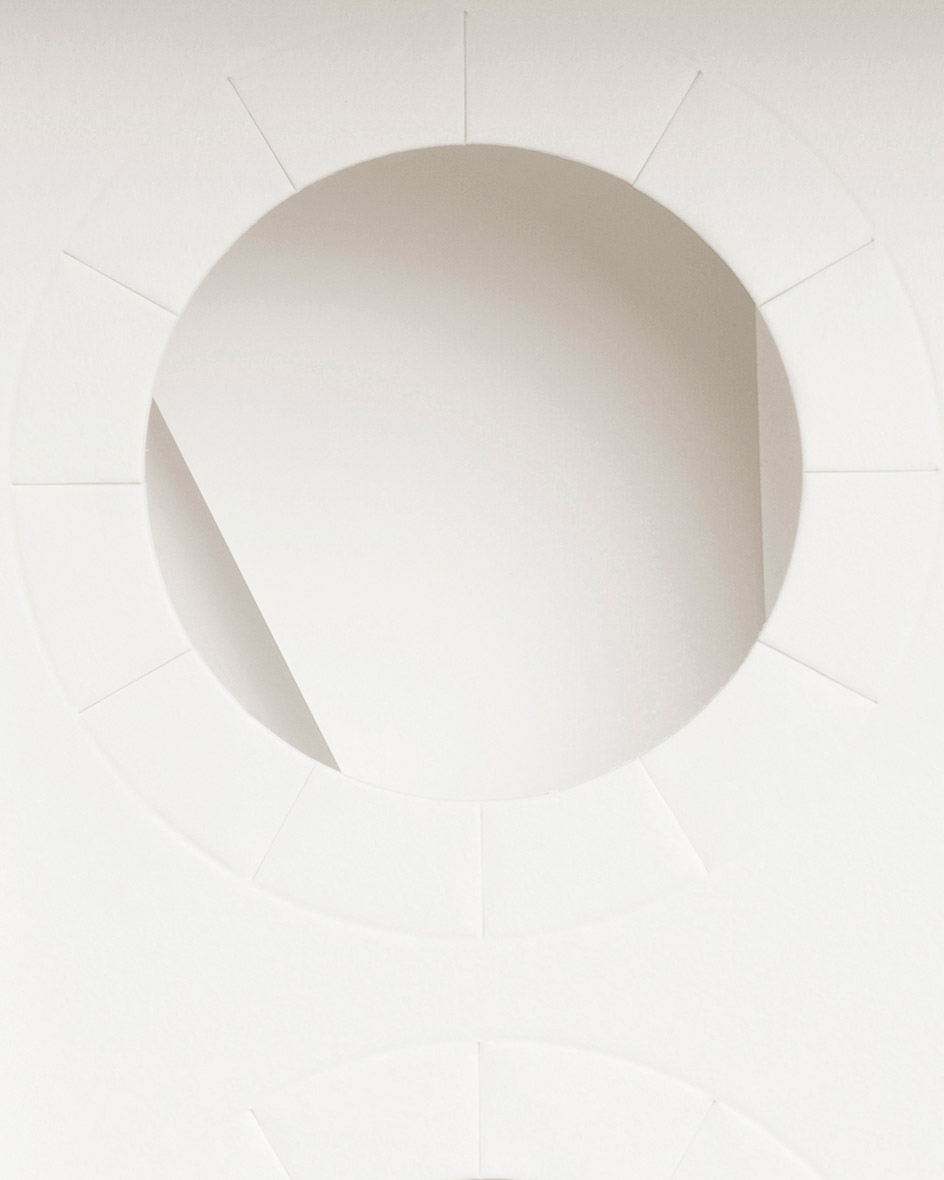 p.Market O DELI and CAFE NATURAL COLLECTION COLORFUL BREAK_C-print, Mounted on Plexiglas, Iron framed_'50 x 40 cm_2015
p.Market O DELI and CAFE NATURAL COLLECTION COLORFUL BREAK_C-print, Mounted on Plexiglas, Iron framed_'50 x 40 cm_2015
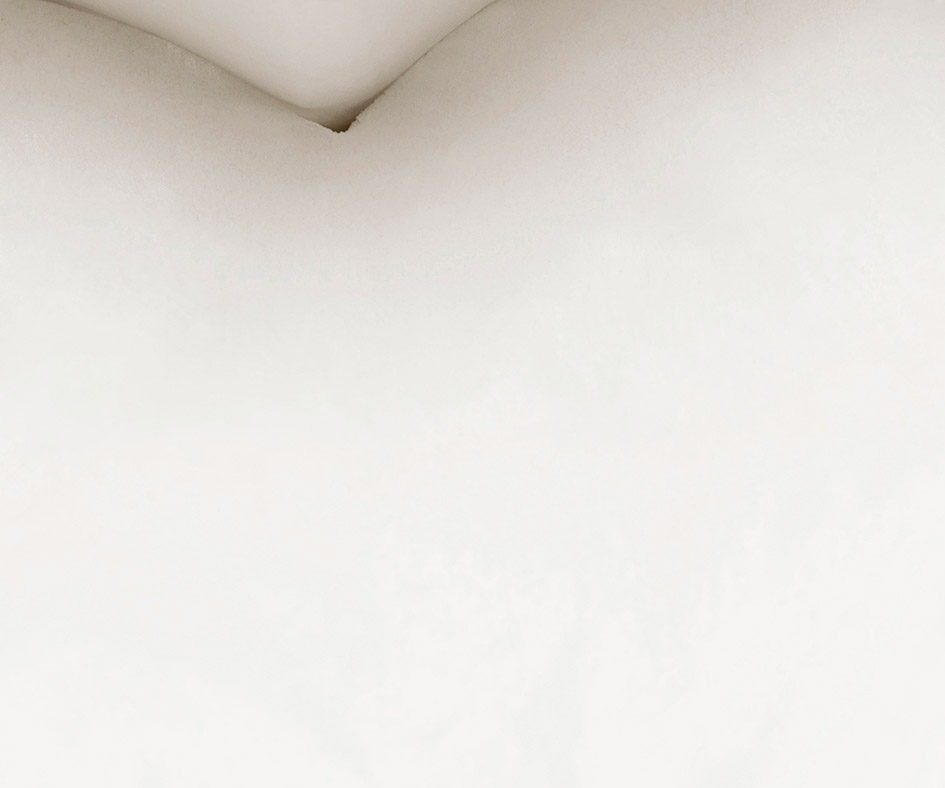 p.Pink Marc de Champagne Truffles Net Wt. 34g (1.2oz) _C-print, Mounted on Plexiglas, Iron framed_'50 x 60 cm_2015
p.Pink Marc de Champagne Truffles Net Wt. 34g (1.2oz) _C-print, Mounted on Plexiglas, Iron framed_'50 x 60 cm_2015



